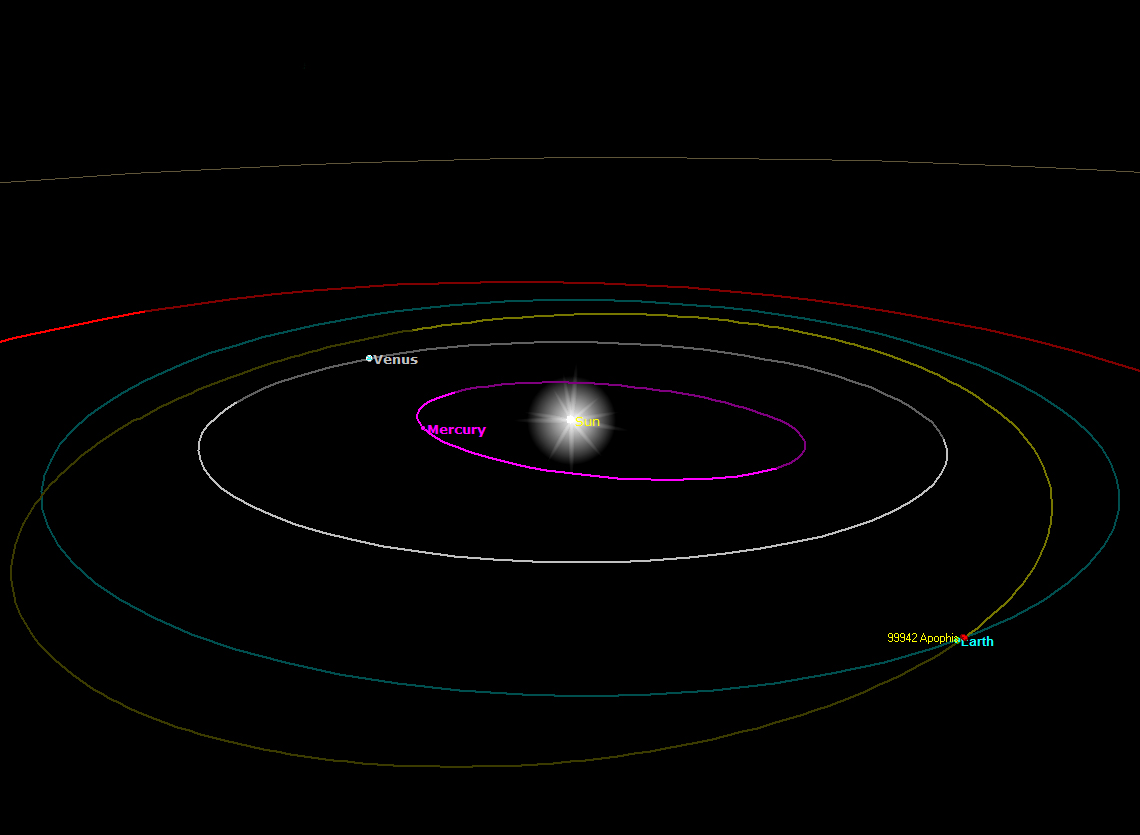Poll
 | 5 votes (38.46%) | ||
 | 3 votes (23.07%) | ||
 | 2 votes (15.38%) | ||
 | 5 votes (38.46%) | ||
 | 2 votes (15.38%) | ||
 | 2 votes (15.38%) | ||
 | 1 vote (7.69%) | ||
 | 3 votes (23.07%) |
13 members have voted

Close approaches
The closest known approach of Apophis comes on April 13, 2029, when the asteroid comes to within a distance of around 31,000 kilometres from Earth's surface. The distance, a hair's breadth in astronomical terms, is five times the radius of the Earth, ten times closer than the Moon, and even closer than some man-made satellites. It will be the closest asteroid of its size in recorded history. On that date, it will become as bright as magnitude 3.1 (visible to the naked eye from rural as well as darker suburban areas, visible with binoculars from most locations). The close approach will be visible from Europe, Africa, and western Asia.
The April 13, 2029, approach distance to Earth's surface is projected to be closer than 31,200 kilometres (19,400 mi) with a 3-sigma uncertainty region of about ±700 km. I hope they did their math right!
The approach in late March 2036 will be no closer than 8.4 million km (5.2 million mi).
In the 2060s, Apophis is expected to again closely approach Earth in 2066. On the April 12, 2068, Apophis could be more than 220 million km (140 million mi) from Earth, making the asteroid further than the Sun. However, on April 12, 2068, the odds of impact with Earth are 1 in 150,000 in large part because the line of variation (LOV) in its calculated orbit extends over 840 million km (522 million mi).
1 in 150,000? Sounds like an interesting prop bet.
2-15-13 a 60 foot diameter meteorite traveling at 40,000 miles an hour Exploded in the atmosphere over Russia. (There are several YouTube videos on this.)
On 15 February 2013, Duende passed at a record distance of 27,700 km (17,200 mi) or 4.3 Earth radii from Earth's surface. It was 98 ft in diameter. (This is closer than Apophis, but Apophis is larger.)
March 2004 an asteroid 100 feet across, named 2004 FH came to within 26,000 miles of the earths surface.
https://earthsky.org/astronomy-essentials/the-yarkovsky-effect-pushing-asteroids-around-with-sunlight
Quote: odiousgambitApparently it is not possible to nail down the future path of such objects even if you have very accurate current data on them. The sun has an effect on them called the Yarkovsky effect ... this is why they can't say for sure what will happen but have to give odds, though it is also possible they aren't satisfied with the data they have.
https://earthsky.org/astronomy-essentials/the-yarkovsky-effect-pushing-asteroids-around-with-sunlight
We should probably close down the economy for two weeks just in case.
Quote: odiousgambitApparently it is not possible to nail down the future path of such objects even if you have very accurate current data on them. The sun has an effect on them called the Yarkovsky effect ... this is why they can't say for sure what will happen but have to give odds, though it is also possible they aren't satisfied with the data they have.
https://earthsky.org/astronomy-essentials/the-yarkovsky-effect-pushing-asteroids-around-with-sunlight
The Yarkovsky effect (radiation pressure of sunlight on a rotating asteroid) will only be significant on close approaches. So after the 2029 close approach they will have much more information with which to predict the asteroids approach distance in 2068.
China is planning an unmanned space shot in 2022 that will last 6 years and has a three part mission
- study Apophosis
- do a flyby on another smaller asteroid
- send an unmanned space probe to land on a third asteroid.
By the way, the second syllable of "Apophosis" is emphasized.
Quote: GreasyjohnLet’s not forget about the Tunguska event of 1908.
https://en.m.wikipedia.org/wiki/Tunguska_event
Tunguska shock wave flattened trees over 830 sq. miles of a remote area of Russia. Attributed to a 100m meteor that disintegrated in the atmosphere about 3-6 miles above the surface. And, remember, Apophosis is estimated to be 470m by 170m, which is somewhat bigger. It is nowhere near an extinction event if it hits Earth, but it would probably be the most important event in human history to date.
I've tried to confirm this by searching but can't find anything exactly.
Quote: billryanIf an object 100 meters by 100 meters entered the atmosphere, wouldn't most of it either burn up or break off so the objects hitting the ground would be only a fraction of the original?
Here’s some information that helps:
Stony asteroids with a diameter of 4 meters (13 ft) enter Earth's atmosphere about once a year. Asteroids with a diameter of 7 meters enter the atmosphere about every 5 years with as much kinetic energy as the atomic bomb dropped on Hiroshima (approximately 16 kilotons of TNT), but the air burst is reduced to just 5 kilotons.[18] These ordinarily explode in the upper atmosphere and most or all of the solids are vaporized.[21] However, asteroids with a diameter of 20 m (66 ft), and which strike Earth approximately twice every century, produce more powerful airbursts. The 2013 Chelyabinsk meteor was estimated to be about 20 m in diameter with an airburst of around 500 kilotons, an explosion 30 times the one over Hiroshima. Much larger objects may impact the solid earth and create a crater.
See entire article: https://en.m.wikipedia.org/wiki/Impact_event
The larger the object, the more chance that it does not burn up in the atmosphere -which would result in an impact crater (Or create a tsunami if it impacted at sea.).
Apophis is commonly called The God of Chaos.


On the above image, the blue orbit is Earth, the yellow orbit is Apophis and the white orbit is Venus. So Apophis orbits the sun and is closer to the Sun than Earth for >50% of its orbit.
This is also pretty goodQuote: Greasyjohnhttps://www.youtube.com/watch?v=4Wrc4fHSCpw
This is a very informative video.


